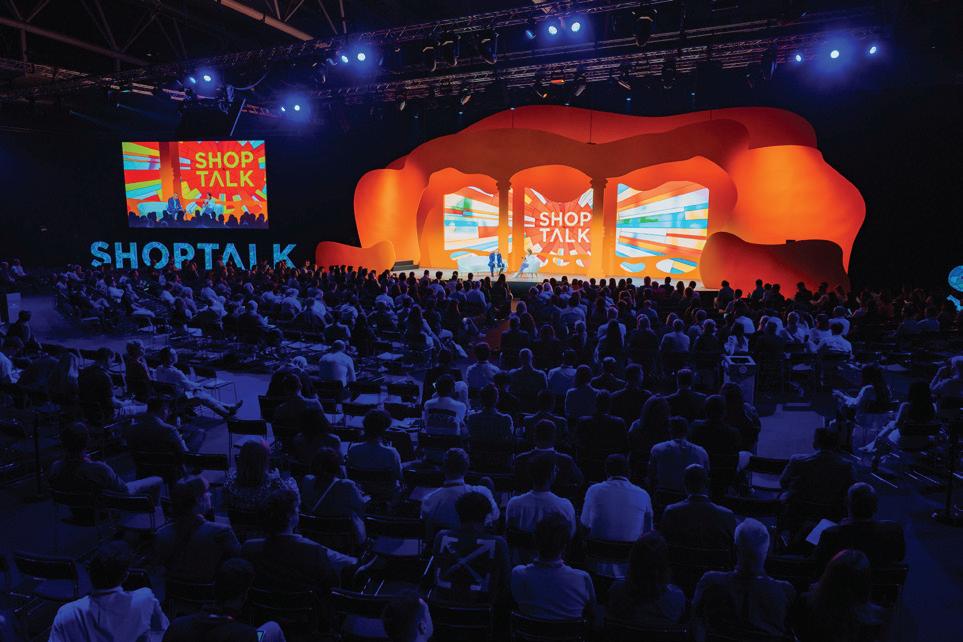










Ecommerce has been held under a turbulent state of affairs in the UK. Faith can be restored, however, as experts reveal the many ways retailers can experience growth despite industry declines.
IMRG’s Index, which tracks online sales for 200 retailers, has presented Year-on-Year (YoY) declines across major ecommerce metrics throughout 2022 and 2023. The steepest decline reported in 2022 was in February, at -31.7% YoY, and the market fell again a year later in February 2023 at -4.7% YoY. Therefore, ecommerce retailers cannot rely on metric consistency.


The pandemic brought astonishing growth, with some online product categories seeing revenue spikes of over +170% YoY. Singling out metric performance now would make it seem that online retail is ultimately in terminal decline. However, online retail performance simply cannot live up to pandemic highs.
UK retailers were hit with further metric unreliability as the cost of living crisis came into full effect, changing customer behaviour such as increased buyers’ hesitancy and reduced loyalty in their search for the best price.




Total market revenue performance has been negative for 26 consecutive months; categories such as clothing and gifts are seeing consistent declines, pulling down market averages. Customers are instead spending their money on
cheaper, more sustainable products such as small appliances, for which revenue has grown close to +50% YoY in recent months.
In line with revenue declines, average conversion rates have been falling since the pandemic. The weekly average conversion rate (total sessions) in 2020 hovered around 5%. Now, they hover around 3%. One of the reasons for this decline is that the cost of living crisis has made it more difficult to move customers through the sales funnel, most noticeably at the ‘add to basket’ stage.
Optimisation techniques for metric reliability

Retailers are pulling out all their cards to experience growth. Creating unique customer experiences through personalisation and AI can increase conversion rates. IMRG research also suggests that price is the top consideration when customers look to buy online, with elements such as discounting being a favourite all year round.




For metric reliability, retailers can use customer data to learn preferences, such as how customers wish to interact with them. They can also monitor their online metric performance relative to the rest of the market to see if their optimisation techniques are working. This approach will enable retailers to adapt their strategy in real time for greater efficiency and growth.

Merchants should consider offering their customers the option to pay using Open Banking, insists Holly Coventry, VP, International Open Banking Payments at American Express.

What is Open Banking?
It’s technology that makes payments faster and easier by sending funds to a merchant’s bank account at the click of a button — which benefits customers and vendors alike. It’s also safe and secure because, unlike paying with debit cards or via BACS, no financial information is shared with anyone. To initiate a payment, all the customer has to do is authorise it through their online banking.
How does Open Banking differ from BACS?
It’s more straightforward. For example, say you want to pay a plumber for services rendered. With Bankers’ Automated Clearing System (BACS), you would need their sort code and account number to make an online transfer.
With Open Banking, all the plumber has to do is send you a link via text message or email, which includes details of the amount to be paid. To agree to it, you click on a button and select which bank you would like to pay through. If you’re using your mobile, you’ll be taken securely to your banking app, via the biometrics or passcode on your phone, to authorise the transaction. You don’t need to manually input their banking details.
How popular is Open Banking?
It is growing faster than contactless payments did on the first launch.
Open Banking Limited — the Government entity promoting Open Banking — reported that 7 million consumers and SMEs used Open Banking services in January. We launched our own Open Bankingpowered payments product, Pay with Bank transfer, towards the end of 2019. JustGiving was one of the first UK merchants to implement it.
Why has retail been slower to adopt Open Banking?
There are a few reasons. First, debit cards aren’t perfect — but they are existing payment products that do the job for both the merchant and the consumer. That makes change harder, particularly in ecommerce scenarios. Also, initially, it was challenging for vendors to make refunds using Open Banking technology. Now, the capabilities and infrastructure have improved, so that’s no longer the issue.
Plus, I think some retailers thought Open Banking would simply mimic debit cards. They need to think outside the box and use it to make small, gradual innovations that will alleviate pain points for the consumer and ultimately enable more Open Banking use cases.
How does Open Banking benefit retail customers?
Apart from being more convenient, it gives them more control because, without authorisation, the payment
won’t leave their bank account. What’s more, most banking apps will allow consumers to check their bank balance first to ensure they have the necessary funds before they make a payment via Open Banking. They don’t have that visibility with debit cards.
How does Open Banking benefit vendors? It helps with cash flow because they receive money in their bank account instantly. It’s also another option for their customers. We’re working with several retailers on using our Pay with Bank transfer product as a way to build better customer experiences. Ask any vendor: good customer experiences are essential. We carried out research earlier this year, which revealed that 42% of shoppers wouldn’t return to a retailer with a slow checkout and payment process; and over a quarter of those surveyed (28%) would not purchase from the retailer again due to lack of choice when it comes to payment options. A further 69% said they don’t want to waste time entering unnecessary details when shopping online, and 61% said they would like greater control and visibility over their finances when making payments. So, I think we’ll see Open Banking increasing in the world of retail.
Amid a worsening cost of living crisis, we have seen some important consumer habits develop in response to brands competing for their loyalty.
Consumers have become increasingly price-sensitive over recent years, with a huge surge in the past year, as revealed by recent research by the Data & Marketing Association (DMA UK) and Tapestry Research, the ‘Customer Engagement: How to Win Back Customers and (Re)Build Loyalty 2023’ report.
Indeed, discounts and promotions are an increasingly important driver of consumer demand in a challenging economic climate, with 51% of UK adults using them to trial new brands and products (up from 44% in 2021). Despite the state of the world around them, consumers are feeling personally empowered by their ability to shop around for the best deals to stretch their tight household budgets.
The downside of more consumers becoming hooked on discounts and offers is a considerable decline in brand loyalty: 63% of consumers claim they often change their mind about what brands/shops/sites to use as a result of deals and offers. Almost half (48%) would even stop buying from a brand if they stopped offering deals, suggesting price sensitivity is increasingly impacting brand loyalty.
Loyalty is on a significant decline in the past 12 months, with 61% of consumers feeling less loyal to brands now than they did a year ago (from 41% in 2022). About 48% of consumers are even diversifying their brand repertoires by using cheaper alternatives alongside their favourite brands.
Price promotions are vital in helping businesses hit their short-term KPIs. However, overuse will result in consumers becoming hooked on deals and offers, displaying higher levels of price sensitivity that, ultimately, eat into profit margins.
Therefore, businesses need a cost of living crisis exit strategy whereby they look to reduce the use of price promotions in the marketing mix and, instead, refocus on brand and customer serviceled reasons to drive loyalty to their brand. A great deal might be good news for a consumer, of course, but we have seen concerns over lower prices possibly meaning worse customer service — which is not good for anyone in the long run. Consumers want a brand that’s reliable and provides value for money. Brands cannot afford to be unfit for purpose while household budgets are under pressure, especially with competition for their loyalty fiercer than ever.
In a time of uncertainty, affiliate marketing provides retailers with the stability they need. Introducing new audiences to products and services, while yielding impressive results.
According to e-retail community IMRG, ecommerce growth was down 10% in 2022. Unsurprising in a cost-of-living crisis. However, affiliate marketing is bucking this downward trend.
What is affiliate marketing?
Affiliate marketing allows retailers to strike up relationships with a diverse range of ‘publishers’ that help them reach new audiences. These ‘publishers’ or ‘affiliates’ can be website owners, bloggers, social influencers, technology partners, and even other brands. They promote the retailer’s products and services on their platforms to drive traffic to the retailer’s channels. If this results in a purchase, the affiliate receives a
commission fee on the sale.
Joelle Mullin is Senior Client Partner at Awin, an affiliate marketing platform helping brands and partners find each other. At the last count, it was working with 2,493 UK retail brands and over 270,000 publishers. Mullin knows affiliate marketing works. While UK retail growth declined in 2022, the company’s UK retail growth surged by 12.4%. High performers include health and beauty (up 21% annually), fastmoving consumer goods (up 53%) and sportswear (up 31%).

Affiliate marketing benefits
“Brands like the affiliate channel because it provides stability in a time of uncertainty — and at a lower cost than pay-per-click,” says Mullin.

“Unlike other marketing channels
where prices are rising, this offers a high return on investment; partners only receive payment on sales made.”
Then there’s market reach, as retailers gain exposure to previously untapped audiences. Naturally, the diverse range of affiliates working with Awin also benefit. “First, they’re paid for the sales they make,” says Mullin.
“Second, it’s relatively easy to enter the affiliate marketing space. All someone needs to start with is a live website or social media channel. With everything from partner discovery, through to tracking, performance, and payments, Awin gives retailers the tools to help monetise partnerships with brands.”

While it’s a growing area for influencers, Mullin admits brands still overlook affiliate marketing. “Unlike other channels, we offer brands and partners full control, choice and transparency. But still, retailers equate it with discount/promotional codes or the last click on a marketing funnel,” she says. “It’s much more than that. It’s an innovative channel; always growing and diversifying. Making it the marketing solution of the future.”
Unlike other channels, we o er brands and partners full control, choice and transparency.WRITTEN BY Ian Gibbs
Consumers want a brand that’s reliable and provides value for money.
How affiliate marketing yields excellent return on investment for retailers
Founded in 2015, UK baby brand MORI creates organic products using soft, sustainable materials in trusted factories. Using Shopify Plus and Shopify Payments, they quickly grew and expanded internationally to the US.
Challenge
In the fast-paced retail sector, keeping up with technological developments to clinch sales is a must — and helping businesses do so is a recognised leader in commerce solutions.
Soaring inflation, price hikes and consumers questioning every purchase have made 2023 challenging for retailers. But helping them to drive growth is Shopify, the global commerce company with the highest converting checkout on the market.

It started over a decade ago, helping businesses like fitness brand Gymshark and outdoor pizza oven company Ooni become household names. With its simple, one-click purchase solution, the platform is used by over 100 million shoppers in 23 countries. They are also revolutionising enterprise commerce, giving retailers the flexible, scalable infrastructure they need to run their businesses. And it’s working, as they were named a Leader in the 2023 Gartner® Magic Quadrant™ for Digital Commerce, placed highest for their ability to execute, and named a Customers’ Choice in the 2023 Gartner® Peer Insights™ ‘Voice of the Customer.’
Helping enterprise retailers scale successfully
In January, they launched Commerce Components, giving enterprise retailers solutions for their specific needs rather than having to build bespoke commerce systems or buy restrictive, off-the-shelf alternatives. From handling colossal product catalogues and complex inventory management to limitless order volumes and multi-channel selling, Commerce Components helps enterprises scale successfully.
Following on from that in July, Sidekick was unveiled — a groundbreaking AI-enabled commerce assistant that
can improve the shopfront, streamline backend operations, build marketing campaigns, automate flash sales, and even engage customers more effectively.
“There’s no corner of the internet that will benefit more from AI than helping businesses to grow, and Shopify is proactively helping retailers harness its potential,” explains Deann Evans, Managing Director, EMEA. “This is just the beginning.”

Solving checkout frustrations boosts conversion
Clunky checkout processes lead to cart abandonment. Shopify’s accelerated checkout drives customer satisfaction and retention, and a study by a Big Three global management consulting firm found overall conversion rate outpaces the competition by up to 36% and 15% on average. Even when not used, having Shop Pay present at checkout increases lower funnel conversions by 5%. Deann says: “Shoppers want comfort and speed at checkout and a payment option they know and trust. If their preferred payment method is absent, they could abandon the purchase. Accelerated checkout solutions like Apple Pay, PayPal, Klarna and more must be available for customers to buy how they want with the ability to save key information, helping them buy faster.”
“Our mission is to make commerce better for everyone, including all brands, regardless of size and geography. We want to help them compete and thrive by offering innovation, choice and flexibility.”
This growth brought challenges; namely, ensuring faster checkout times for customers, and they wanted to identify the value that Shopify Payments and, in particular, the accelerated checkout Shop Pay delivers. As the most popular payment method amongst MORI’s customers, the team wanted to ensure that it could continue to work for them.
Solution
Following an internal analysis, both UK and US results clearly showed that an accelerated checkout solution could deliver valuable results for its business. From helping to reduce abandoned checkout rates to driving revenue growth through higher-value baskets, the benefits of choosing an accelerated option made it obvious that choosing another route could harm revenue.
It also highlighted further benefits. In the US, it has the flexibility and control to offer Shop Pay Instalments simply by switching it on via its admin, without needing to run complicated installations and technical contracts—something that, if missing, would waste precious resources for the team, rather than focusing on optimising the store for customers.
Results
The partnership with the ecommerce platform, and Shop Pay particularly, has continued to positively impact the business. Over half (55%) of its customers use it, and those who do spend, on average, 13% more. In total, MORI has witnessed an 8.5% increase in conversions from Shop Pay users.”
accelerated checkout boosted conversion by 8.5%
The partnership with the ecommerce platform, and Shop Pay particularly, has continued to positively impact the business.
An order management system can help retailers and brands increase sales, improve operational efficiencies and, critically, enhance the customer experience.
Today’s omnichannel approach makes shopping easier for consumers, notes Joe Till, Sales Director UK & Nordics at order management specialist, OneStock. Unfortunately, it makes behind-the-scenes operations painfully complex. That’s why an order management system (OMS) is indispensable.

Full visibility with an order management system “Stock can be fragmented across multiple locations,” explains Till. “It could be in-store, in warehouses, at the manufacturer or with a distributor. What an OMS does is help a brand or retailer centralise, manage and orchestrate that complexity by offering them full inventory visibility so they never lose a sale.”
From a technical standpoint, a good OMS should be ‘composable commerce’ — architecture that enables brands to easily coordinate all their best-of-breed commerce solutions. It should be simple to adopt and integrate with other technology.
However, an OMS shouldn’t be confused with an Enterprise Resource Planning (ERP) system, a back-office platform, which includes inventories, prices and other stock data. ERP is not designed to manage, track and optimise the order cycle from point of sale to delivery. That’s the job of an OMS.
Multiple benefits of an order management system
“Retailers can use an OMS to sell more stock faster and in a more convenient, operationally efficient way,” says Till. “They can reduce their stock and so reduce their internal and logistics costs to maximise their margins. They can avoid constant ordering and — by favouring stock points offering delivery methods with the lowest CO2 emissions — improve their sustainability. Finally, because an OMS can facilitate timely delivery, it helps increase customer satisfaction.”


All shoppers want a great customer experience. If they don’t get it, they’ll go elsewhere. Alarmingly, statistics from OneStock show that 69% of shoppers will switch to a competitor’s site if stock is unavailable online, and 55% will turn to a competitor if a product is out of stock in-store.
“Brands and retailers have to expect the unexpected; be it a pandemic, transport strike or roadblock,” adds Till. “An OMS can help them keep agile and adapt their selling and delivery strategies. It’s a key asset.”
Selling products and services online enables businesses to easily reach a global audience, removing traditional barriers and levelling the playing field for smaller firms.
The UK is one of the world leaders in ecommerce, being the third most-shopped market for international online purchases, behind only China and the US.1, Clearly, there is a huge demand for British products and services around the world, especially when it comes to buying via the internet. However, understanding how to take advantage of this can be challenging.
The Department for Business and Trade (DBT) is the UK Government’s department for economic growth. It advises and supports British companies to help them export and grow.
WRITTEN BY Tony GreenwayThis includes support specific to ecommerce companies. Ecommerce advisers, based around the UK, have a wealth of experience and can offer tailored support, including assistance to create an ecommerce export strategy and recommend the most appropriate online marketplaces. There is a range of help available for every aspect of selling internationally — and it’s all free. On DBT’s website, UK firms can:
• Create a tailored export plan
• Work through learning modules to build knowledge of how to sell internationally
• Identify high-potential markets for their products/services
• Explore and enquire about finance and insurance support from UK Export Finance

The UK Export Academy is a training programme for British businesses looking to grow their international sales. It’s delivered in three stages, depending on skill level. Information on other events that DBT delivers or is involved in — including webinars, trade shows and workshops — is on its events calendar.
For any questions that UK companies have about selling internationally, the Department’s Export Support Team can help. The team provides guidance on topics such as selling to new markets, paperwork needed to export goods and rules for delivering services in, or to, a specific country.
Businesses that have an exportready product or service may be eligible for the Department’s international market support. The service provides one-to-one help from in-market advisers, market intelligence and introductions to private-sector service providers.
Reference 1. Source -- Global Voices 2021: Cross-Border Shopper Insights survey
Why an order management system is an indispensable retail tool
There is a huge demand for British products and services around the world, especially when it comes to buying via the internet.


The retail landscape is rapidly evolving, with paradigm shifts in how customers shop and engage with products; the unbeatable growth of conscious commerce and peer-to-peer buying/selling platforms; the transformative power of artificial intelligence (AI); and the increasing expectations of the consumers — all of which are challenging the retailers’ agility to implement innovative solutions.
A vast majority — if not all brands — are investing large sums in evolving the customer experience to drive their future and often struggle to see the return on this investment. Net promoter score (NPS) is a popular method of measuring progress towards this goal. However, the value added for customers is limited due to the underutilisation of data and insights during the creative and engineering stages.
Customer-centric engineering has emerged as a powerful paradigm that is revolutionising the retail and ecommerce landscape. Unlike traditional product-based approaches, customer-centric engineering places the needs and preferences of customers at the heart of the entire design and development process.
Open Reply’s forward-thinking methodology leverages advanced technologies, data analytics and customer insights to create personalised, seamless and engaging shopping experiences. It also enables companies to anticipate client needs


— now and in the future — which can lead to long-term, enhanced customer relationships.
How reverse commerce benefits all stakeholders
In a world seeking eco-friendly and economically conscious solutions, reverse commerce emerges as a transformative trend that empowers individuals and businesses alike to play a vital role in preserving our planet’s resources. Reverse commerce (or re-commerce) revolutionises the way we perceive consumerism by embracing a sustainable approach to buying, selling and trading used goods — ultimately extending product life cycles.
Reverse commerce presents a win-win scenario for all stakeholders involved. Consumers benefit from accessing high-quality, pre-owned products at a fraction of the original cost. It enables budget-friendly choices without compromising on quality — while reducing waste.
For businesses, Portaltech Reply strategises and facilitates the integration of reverse commerce into its digital commerce solutions. It provides new ways for businesses to engage with their audience. By offering certified, refurbished products, companies can broaden their customer base, gain brand loyalty and foster a positive brand image through sustainability efforts.
Reverse commerce presents a unique chance for businesses to thrive sustainably and for consumers to make conscious choices — moving us closer to a world where sustainability is at the heart of every transaction.
The transformative power of AI in retail AI is revolutionising operations, improving efficiency and reshaping the shopping experience. Vast data analysis, real-time inventory tracking, personalised product recommendations, demand forecasting and resource allocation are just the tip of the iceberg. The combination of AI, machine learning and robotics is propelling us towards an era of automated commerce, with customer-centricity at its heart.
Retail Reply’s robust AI framework, paired with in-depth retail expertise, is driving forward business strategies for clients and enabling a return on AI investments. Businesses can then make smarter, data-driven decisions that deliver enhanced customer experiences, sales growth and better brand loyalty.


In conjunction, Canvas Reply applies user-centric design and agile web development to integrate breakthrough technologies such as generative AI, predictive personalisation and immersive mixed-reality into digital experiences.
As the boundaries between physical retail and digital commerce blur, they are actively laying the groundwork for the future of retail and ecommerce. The sector must now leverage specialised expertise and consider the immediate opportunities presented. With these solutions, retail companies can optimise operations and deliver seamless, personalised and meaningful shopping experiences that foster sustainable brand loyalty and growth.
The way people shop is constantly changing. To keep consumers engaged, the retail sector must employ new and sustainable solutions that can improve the shopping experience.
sustainable,WRITTEN BY Giovangabriele Tricomi Partner, Portaltech Reply WRITTEN BY Richard Gillings, Partner, Retail Reply WRITTEN BY Alexander Reekie Partner, Canvas Reply WRITTEN BY Daren Ward Partner, Open Reply
AI is revolutionising operations, improving e ciency and reshaping the shopping experience.Image provided by Reply WRITTEN BY Richard Mould Senior Strategy & Policy Lead, Open Banking

Open banking has already established itself as a safe and convenient way to make payments. This new way to pay provides a great opportunity to help transform ecommerce payments.
These payments were designed for the digital world and are helping to transform the online buying experience with growing numbers of shoppers choosing this secure and intuitive way to pay for purchases, eliminating the need to manually enter card details. There are many advantages for vendors, too.
Open banking provides the opportunity for ecommerce merchants and retailers
— from multinationals to one-man bands — to save money on their transaction costs when compared to the fees associated with taking cards. One B2B retailer told us that card processing costs were growing out of proportion to its sales revenue, to the point where card processing costs were eventually taking up 10% of its pre-tax profit.

Open banking also tackles other common payment pain points by enabling fast settlement of payments and simplifying the reconciliation of accounts, which streamlines administration.
As with any innovation, familiarity is key, but with more consumers (a recent survey said 30%) regularly using banking apps, those online and high street retailers that offer a ‘pay by bank’ option as part of their payment mix will see adoption continue to grow. Already, UK shoppers can choose to make an open banking payment on one of the world’s largest online shopping platforms — a leading European home furnishings brand, a major high street health retailer and a popular DIY store.
Another advantage offered by open banking is the ability to offer faster refunds. Open banking payments are direct account-to-account payments, so if a refund is needed, there is no longer the frustration of having to wait up to five days to receive a refund. Consumers could see their money refunded immediately. This latest chapter in the payments story is long overdue, and we have only scratched the surface. As adoption continues to grow, it’s a necessary win–win for both consumers and businesses.
Relevancy drives excitement, frequency and the foundation of loyalty. Nearly two-thirds of consumers expect companies to offer relevant products, services and experiences.

Brands and retailers are constantly looking to leverage first-party data to elevate the customer experience and drive revenue, factoring in changes in shopping habits. Giving insight into ecommerce trends, Rokt conducted a consumer research study alongside Harris Poll.
The Harris Poll data shows that UK consumers have increasingly sophisticated expectations for online shopping. This, combined with the cost of living crisis, shows the urgency for effective advertising that shows customers the best deal and what they really need. The global study — with respondents from the US, UK, France, Germany, Australia and Japan — compares trends with the UK:
• In the UK, 52% of consumers express a desire for increased availability of loyalty programmes, compared to a global figure of 42%.
• About 45% of UK shoppers want to see an easy checkout process, as opposed to 36% worldwide.
• An impressive 67% of surveyed UK shoppers express the need for relevant offers during the checkout process, which is 10% higher than the global average.
• In terms of checkout frustrations, 39% of UK consumers said that they were annoyed by an excess of ads, slightly above the global average of 34%.
• Having to manually input payment information was also a source of frustration, with 26% of UK shoppers finding it bothersome compared to 20% globally.
• UK shoppers exhibited a 5% higher likelihood (34%) than the global
average (29%) to find a different site when encountering checkout frustrations or barriers.
Generation Z believes in AI
The study found that Gen Z consumers are globally more optimistic about AI’s role in ecommerce, with 55% of respondents interested in an AI assistant that would make online shopping more convenient by simplifying product discovery and anticipating their needs and desires. Gen Z believe that AI will improve their online shopping, especially in these five ways:
• Compare prices (47%)
• Find deals (45%)
• Receive relevant offers and product suggestions (41%)
• Receive personalised assistance (37%)
• Find reviews (28%)
Driving relevancy through data is key
Achieving relevance is increasingly critical for brands. Faced with a vast array of choices, consumers are turning to brands that pre-empt their needs, streamline the discovery of personalised offers at opportune moments and facilitate seamless checkouts. Brands that neglect these risk higher cart abandonment rates. By leveraging first-party data, analytics and machine learning, brands can foster customer enthusiasm and loyalty.

UK shoppers can choose to make an open banking payment on one of the world’s largest online shopping platforms.
Two-thirds of British shoppers want relevant offersWRITTEN BY Elizabeth Buchanan Chief Commercial Offi cer, Rokt
Innovative software is helping a range of leading brands and fashion retailers more effectively reach their marketplaces across Europe.
Getting the latest designs and fashion brands to customers ahead of competitors has long been a major challenge for manufacturers and retailers. Picking the right market at the right time, or knowing when to expand to a new marketplace, has been key in staying ahead of rivals — long before the digital era.
Cross-border fashion retail
With every second ecommerce pound spent on marketplaces, the European marketplace industry has undergone substantial change and continues to evolve rapidly. In today’s landscape, access to relevant customer data is critical. It is equally important to possess an intuitive understanding of the market, relevant experience and knowledge of current trends.
When effectively combined, these elements can transform the latest dress, training shoes or accessories into best-selling items. Tradebyte stands out as an expert in this field, backed by years of substantial digital expertise. Its innovative software offers access to over 90 marketplaces across 20+ European markets and supports retailers and manufacturers in bringing their products swiftly onto customers’ laptops, mobile phones, tablets or desktops.
Software for managing products
As an enabler of cross-border digital fashion retail in Europe, the company offers solutions to a range of renowned brands. The company emerged in 2009 at the early stages of online shopping; and in the years since, it has remained an important player in online fashion. Since 2016, it has been part of the Zalando Group but retains independence from the platform.

Alexander Otto, Head of Corporate Relations at Tradebyte Software GmbH, points to its all-in-one software solution TB.ONE, which is designed to help brands and retailers reach customers on their favourite online shopping platforms. It includes product steering and order management, which is a Software-as-a-Service, hosted and developed by the company with a license fee for the brands and uses data to seamlessly connect brands to various European marketplaces.
Efficient marketplace and pricing models
The tool ensures brands meet marketplace criteria, such as relevant images, text and bullet points to describe products. “We bring it all together and map it to the right product and compile them for the right marketplaces,” adds Otto.
The solution is ‘built for fashion.’ Tools and services are designed for fashion brands to be successful and profitable. In order to do so, they have developed a pricing model that is extremely focused on partnership and success.
Flexible network ecosystem
At the core, the software offers tailored services which are delivered by the team to identify and expand into new markets. “Sales may be going well on Zalando in Germany, for example, so it may then be a case of testing the market in Poland, Ireland, England or anywhere Zalando has an online presence,” Otto explains.
“It is all about bringing the right players together. Once you are in that ecosystem, it is easy to add others or stop with one and go to another country or expand. We help brands set up and build their own marketplace and withdraw from a market or platform. The software links retailers and brands to a marketplace — or marketplaces to retailers.
Enhancing digital setup
Otto also warns that some brands remain digitally naïve and are not yet built on a digital mindset. “They may have a strong wholesale background and are organised from a team and business perspective but lack agility and may not even have a dedicated department for ecommerce or online retail.
“The days in ecommerce where you can just throw your stuff out are over. It is a billion-dollar business, and everyone is watching. If a brand has a good digital setup, this expedites every process,” he adds, pointing to Tradebyte as an enabler with the technical and process acumen to help make marketplace businesses successful.

In today’s landscape, access to relevant data is critical.INTERVIEW WITH Alexander Otto Head of Corporate Relations, Tradebyte Software GmbH WRITTEN BY Mark Nicholls
Global sales via ecommerce make up a growing share of international trade in goods. Levels of ecommerce penetration across the world are forecast to rise until 2026 – with the strongest growth in North America, Asia and the ASEAN states.
these areas by countries across the world, which will have knock-on consequences for ecommerce trade.
WRITTEN BY William Bain Head of Trade Policy, The British Chambers of Commerce
In no global region is ecommerce nearing saturation point, with its rise during the pandemic showing little sign of slowing down.
Sales of fashion and consumer electronic goods are particularly strong via ecommerce — with those via smartphone and among younger age groups showing the highest growth. However, still well over 70% of online baskets are abandoned before the sale is completed.
How can policymakers balance the desirability of expanding ecommerce trade with concerns about security, sustainability, carbon leakage, subsidies and supply chain attestations? A variety of legislative measures are being adopted in
The EU’s Carbon Border Adjustment Mechanism (CBAM) reporting requirements come into effect for companies outside the EU in October. This means proof of the origins of iron or steel embedded in products will have to be made by the importer. Packaging legislation also requires exporters to be compliant about the sustainability of packaging products they use to ship goods, particularly those involving plastics.
At the World Trade Organization (WTO) level, 76 countries agreed to undertake negotiations on traderelated aspects of ecommerce in
2019. These negotiations have expanded into eight groups working on issues such as online consumer protection, electronic signatures and authentication, unsolicited commercial electronic messages and paperless trading.
The number of participants in the WTO negotiations has now risen to 89. As of July 2023, the co-convenors committed to wrapping up negotiations by the end of the year, with agreement hoped for on ‘Single Windows,’ personal information and data protection provisions by the end of summer.
Alongside these multilateral steps, some countries have liberalised digital trade through bespoke agreements either of a freestanding nature or within new trade agreements, such as the UK-Singapore or UK-Ukraine Digital Economy Agreements. These steps may unlock the door to continued expansion in cross-border ecommerce trade and determine regulatory principles, which protect consumers and ease ecommerce across the globe.


The growth of online shopping and sales show no signs of abating, but more consideration must be given to the regulation of ecommerce to ease trade barriers and protect consumers.
Packaging legislation also requires exporters to be compliant about the sustainability of packaging products.
Well over 70% of online baskets are abandoned before the sale is completed.


















environmentally friendly!



They are fun and cute and super convenient.. we love them













My kids love it and they’re helpful when you can’t leave the house!











Businesses are urged to adopt an advocacy-first mindset to help them grow sustainably and navigate the challenges presented by the economy and AI.
Brands are finding it increasingly difficult to achieve profitability through spiralling acquisition costs and diminishing customer loyalty. However, an industry expert believes ecommerce businesses that nurture customer advocacy will grow sustainably.
Brands must act now
Mention Me warns that marketing effectiveness will be increasingly impacted by generative AI and that businesses that do not adapt will be left behind. “Brands must start now to build a customer-obsessed growth engine,” says Andy Cockburn, CEO and co-founder.
Analysis beyond spending habits
Businesses that use data to view customers from a RFM (recency, frequency and monetary) perspective are ‘looking at them only through the spectrum of their wallet’ and not with a view of the additional value they can bring through promoting a brand. Harvesting data beyond spending habits — such as positive reviews, social media posts and referrals — provides a better understanding of a ‘valuable customer.’
Insights into real customer value

Mention Me have just launched the world’s first Customer Advocacy Intelligence Platform. Data-driven and powered by artificial intelligence (AI), it provides direct-to-consumer
(D2C) brands with unique advocacy insights.
“We enable brands to accurately predict the true value of a customer advocate and what they will bring to a brand in the future,” he says. Working with over 500 D2C brands — including Puma, Michael Kors, Nutmeg and ManyPets — Cockburn says the platform provides the fuel for the customer-obsessed growth engine.

Hidden customer value
Noting that major brands are recognising the value of customer advocacy, Cockburn says: “We are getting them to change the focus away from high spenders to their most valuable customers, which are their advocates.” He mentions a customer who spent £84 with an online florist — and then referred four people who, together, spent £1,500. “Suddenly, that transforms the view of how that customer should be treated; they are a true VIP,” he explains. “But, unless you have the data, you can’t engage with customers like this to drive greater value.”
Nurturing advocacy

“Using unique advocacy data and insights, brands can maximise value from their entire customer base — even outside of the buying cycle. By nurturing ‘customer love’ through advocacy, businesses can drive retention and deliver unbeatable economics,” concludes Cockburn.
customers?
Unless you have the data, you can’t engage with customers like this to drive greater value.Paid for by MentionMe